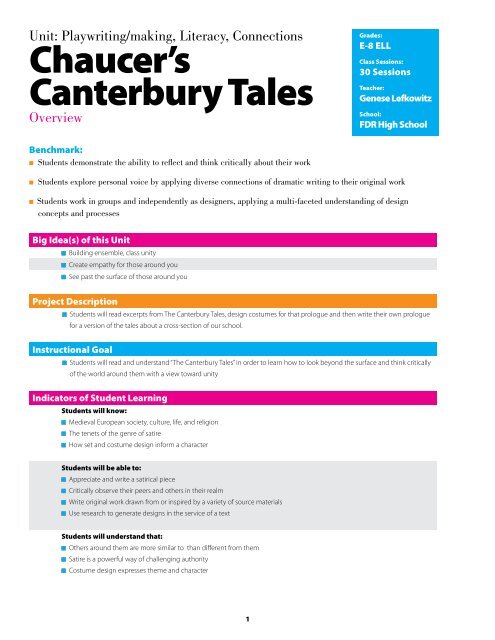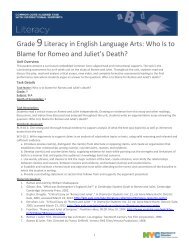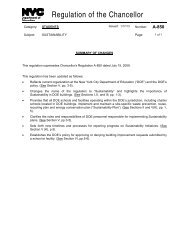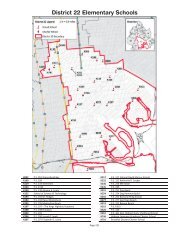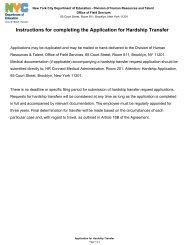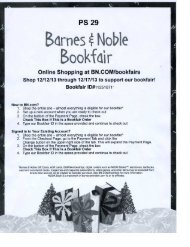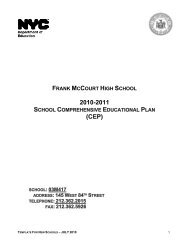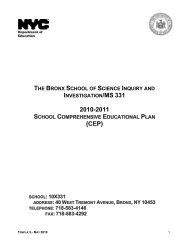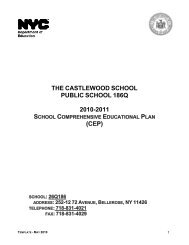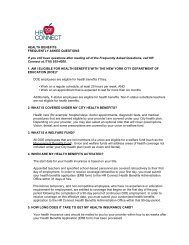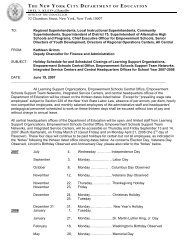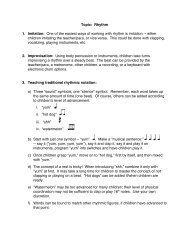Chaucer's Canterbury Tales (English Language Learners)
Chaucer's Canterbury Tales (English Language Learners)
Chaucer's Canterbury Tales (English Language Learners)
Create successful ePaper yourself
Turn your PDF publications into a flip-book with our unique Google optimized e-Paper software.
Unit: Playwriting/making, Literacy, Connections<br />
Chaucer’s<br />
<strong>Canterbury</strong> <strong>Tales</strong><br />
Overview<br />
Grades:<br />
E-8 ELL<br />
Class Sessions:<br />
30 Sessions<br />
Teacher:<br />
Genese Lefkowitz<br />
School:<br />
FDR High School<br />
Benchmark:<br />
n Students demonstrate the ability to reflect and think critically about their work<br />
n Students explore personal voice by applying diverse connections of dramatic writing to their original work<br />
n Students work in groups and independently as designers, applying a multi-faceted understanding of design<br />
concepts and processes<br />
Big Idea(s) of this Unit<br />
n Building ensemble, class unity<br />
n Create empathy for those around you<br />
n See past the surface of those around you<br />
Project Description<br />
n Students will read excerpts from The <strong>Canterbury</strong> <strong>Tales</strong>, design costumes for that prologue and then write their own prologue<br />
for a version of the tales about a cross-section of our school.<br />
Instructional Goal<br />
n Students will read and understand “The <strong>Canterbury</strong> <strong>Tales</strong>” in order to learn how to look beyond the surface and think critically<br />
of the world around them with a view toward unity<br />
Indicators of Student Learning<br />
Students will know:<br />
n Medieval European society, culture, life, and religion<br />
n The tenets of the genre of satire<br />
n How set and costume design inform a character<br />
Students will be able to:<br />
n Appreciate and write a satirical piece<br />
n Critically observe their peers and others in their realm<br />
n Write original work drawn from or inspired by a variety of source materials<br />
n Use research to generate designs in the service of a text<br />
Students will understand that:<br />
n Others around them are more similar to than different from them<br />
n Satire is a powerful way of challenging authority<br />
n Costume design expresses theme and character<br />
1
Unit: Playwriting/making, Literacy, Connections<br />
Chaucer’s <strong>Canterbury</strong> <strong>Tales</strong> continued<br />
Overview continued<br />
Pre-Assessment/Planning<br />
n Have I taught these students before?<br />
Yes, I have taught the majority of them previously<br />
n What do students already know and understand about this area of Theater Making?<br />
The conventions of script writing<br />
How playwrights express characterization through dialogue<br />
How to find and interpret subtext<br />
n What skills related to this unit have students already developed?<br />
How to find characterization<br />
How to write in iambic pentameter<br />
How to take clues from text to do visual designs<br />
n What activity might I use as a pre-assessment tool?<br />
Free writing on topics like hypocrisy, cliques, religion, etc<br />
n How will the students’ needs be addressed?<br />
Go slowly and use many visuals due to their status as ELLs<br />
Unit Assessment Strategies: What is the evidence of student learning?<br />
Self-Assessment<br />
n Rubric and checklist for the costume design<br />
n Reflective essay at the end of the project<br />
Peer Assessment<br />
n Peer evaluation of their classmates costumes<br />
Teacher Assessment<br />
n Grade designs according to rubric<br />
n Analyze students reflections<br />
Teacher Self-Assessment<br />
n Notes to self over the course of the project<br />
n Reflective essay<br />
2
Unit: Playwriting/making, Literacy, Connections<br />
Chaucer’s <strong>Canterbury</strong> <strong>Tales</strong> continued<br />
Overview continued<br />
Learning Experiences<br />
Play improv and theatre games to build team unity<br />
Theater Strands<br />
making literacy connections<br />
u<br />
resources<br />
Look at some professional costume sketches u u<br />
Research and costume characters in Chaucer’s Prologue u u<br />
Critique their classmates designs u u<br />
Collaborate to write a prologue of their own to reflect their school u u<br />
careers<br />
Provide visual designs (such as costumes, sketches, collages and drawings)<br />
to accompany their characters<br />
u<br />
3
Unit: Playwriting/making, Literacy, Connections<br />
Chaucer’s <strong>Canterbury</strong> <strong>Tales</strong> continued<br />
Pre-Planning Assessment:<br />
Assignment<br />
Chaucer’s The <strong>Canterbury</strong> <strong>Tales</strong> is a SATIRE, a piece of writing which makes fun of those in power. Two areas where<br />
people have power over others are religion and politics. Chaucer points out the hypocrisy of these two power structures<br />
in the Middle Ages through his character descriptions in the Prologue. To get you started thinking of satire,<br />
free write a paragraph about what comes to mind about religion, politics and hypocrisy in today’s world.<br />
Student Freewrites:<br />
Ivan<br />
Many religions in this world, some people are trust on them. And some people are not. Believing in the religions is<br />
not a bad thing beside people believe not too much. Not too much depending on it. In China, there is a kind of the<br />
religion called “Fa-lun Gong”, which harms Chinese very much. The leader of this religion, Lee, says this religion<br />
can treat any diseases, people do not have to go to the doctor, and people would go to the heaven after they dead, he<br />
asked people to do many things that against the humanism. If he is caught in China, he would be shoot by punishment.<br />
And he now is in the American, and got a political asylum. Now on the Eighth Avenue, many people who support<br />
this religion are using the name of this religion to attack the Government of China. People should not believe the<br />
religion very much. The God would bless people who do not do things transgress.<br />
Amanda<br />
Firstly, I think most politicians are hypocritical. For example, if a politician runs in an election, he or she will make<br />
some promises for people to get their support. However, when he or she wins the election, the politician does not do<br />
what they should and what they promised during the election. Most of them say in one way and do it in another way.<br />
Second of all, people have different religions in today’s world. Some of them even do not have a religion. Comparing<br />
with history, people have more freedom to choose what they believe. It is a huge change, but it will confuse people<br />
that who is the real god. Finally, most countries in today’s world are republican or democratic. The government will<br />
be selected by people, and it will be controlled by people. All the people should have power and responsibilities in<br />
the country. Everything should follow the laws that people make. The country should be run with the laws not the<br />
government. Therefore, today’s world is very different from the world in history.<br />
4
Unit: Playwriting/making, Literacy, Connections<br />
Chaucer’s <strong>Canterbury</strong> <strong>Tales</strong> continued<br />
Costume Design Project<br />
Phase One: Costuming the Characters.<br />
Each student will be randomly assigned one of the characters we studied in the Prologue. The first part of your project<br />
is to research and create an accurate costume for your character. It must be original work, do not copy something<br />
exactly as you see it. Use what you see as a springboard and adapt accordingly.<br />
n Remember all aspects of the character given by the author must be depicted! (For example the Franklin’s white<br />
beard or the Wife of Bath’s gap teeth.) Is your character described as holding/carrying something? It must be<br />
included. How about colors?<br />
n Your costume must be historically accurate to time, place, social class, and style. Do online research (hint, put<br />
“historical costume” into your browser and follow the links) or use costume books from the school or local library.<br />
Be careful about details!<br />
There are several different ways to do this. Choose which ever you like, but they range in difficulty and point<br />
value. The easiest, number one, is worth the least while number four gets you extra credit!<br />
1 A one dimensional drawing: You may use a model template to draw the costume.<br />
2 A two dimensional drawing: You may use a model template as a base and draw a basic costume, then build it<br />
up with appropriate fabric and materials.<br />
3 A three dimensional small scale model: Dress a doll in an appropriate costume.<br />
4 A life-sized model: Dress a friend, classmate or yourself appropriately.<br />
n Remember the little details from hats and hair styles down to shoes and props; it all counts!<br />
n Lastly, you must include a TYPED full page explanation of your creation. Explain what you got from Chaucer,<br />
what you added, and what you adapted from your sources. You must include the bibliographic information on your<br />
sources. Remember the proper format!<br />
My character: _ _ _ _ _ _ _ _ _ _ _ _ _ _ _ _ _ _ _ _ _ _ _ _ _ _ _ _ _ _ _ _ _ _ _ _ _ _ _ _ _ _ _ _<br />
Costume due date: _ _ _ _ _ _ _ _ _ _ _ _ _ _ _ _ _ _ _ _ _ _ _ _ _ _ _ _ _ _ _ _ _ _ _ _ _ _ _ _ _<br />
5
Unit: Playwriting/making, Literacy, Connections<br />
Chaucer’s <strong>Canterbury</strong> <strong>Tales</strong> continued<br />
Costume Design Project<br />
Costuming the Characters Check sheet.<br />
Fill out as much as you can before researching. Then adapt as necessary.<br />
Character:<br />
Form:<br />
I ) What are the specific details mentioned by Chaucer about how my character looks?<br />
II) What is the _____ of my character?<br />
n area<br />
n social status<br />
n type<br />
III) Specific details: Including colors<br />
n Hairstyle, hat/head covering<br />
n Clothing:<br />
n Shoes:<br />
n Jewelry:<br />
n Props:<br />
6
Unit: Playwriting/making, Literacy, Connections<br />
Chaucer’s <strong>Canterbury</strong> <strong>Tales</strong> continued<br />
Costume Design Project: Student Work<br />
Val Grysko’s Franklin costume doll explanation<br />
Let me start from the top of my Franklin. On his face, as you can see, or as you have noticed (I hope you have done<br />
so) I put a blonde beard. I did so because of the line “White as a daisy petal was his beard.” Actually, I don’t really<br />
know what the author meant by white - - blonde or gray. I decided to put blonde since it was easier!<br />
Now, let me explain the way I dressed the body and the legs. I chose this style since the picture I researched. The<br />
white sweater or shirt is like underwear, which in the medieval times was white, gray, or pale. I chose brown color for<br />
his short-sleeve vest and pants because there were not that many colors. What about boots? I made them black cause<br />
it was common (actually it is even now) for men’s boots to be dark.<br />
I hope you saw that I made him kind of fat. It is since when the narrator described Franklin, most of the time he spoke<br />
about food. For example, “His house was never short of bake-meat pies/Of fish and flesh and these in rich supplies.”I<br />
gave him a white belt because of the line “His girdle white as morning milk.” I also gave him a sword and a purse<br />
and I attached it to the belt because of the lines “A dagger and a little purse of silk/hung at his girdle.” Indeed, I put<br />
the purse in the back since I saw that in a movie.<br />
Ewelina Pietrucha’s Pardoner costume doll explanation<br />
In The <strong>Canterbury</strong> <strong>Tales</strong>, by Geoffrey Chaucer, the author presents different classes of society in Medieval England.<br />
Pardoner is the satiric character from the church. He has long yellow lock hairs, which fall down on his shoulders.<br />
He also has big, bossy eyeballs. On his head, he does not have a hood, he has a little cap. In his hood he keeps his<br />
money, on his lap. He has metal cross with stones, Pardoners cheats people, that is why he has a lot of money. He has<br />
many thing which he considers that in the past they belonged to saint people. For example he has a pillowcase which<br />
he claims that it is veil of The Virgin Mary. Also he has pieces of Saint Peter sail. The last thing which he has is<br />
glass jar with pig bones. He considers it as saint’s relics.<br />
In the Middle Age people from the church like Pardoner we can compare with Benedictine monks. Monks spent most of they<br />
time praying or teaching, writing and reading. Monks usually work black shoe made of leather. They often wore plain habits in<br />
brown, grey, dark blue, or red colors. The habits were tied with rope belt. They had cross upon a chain around their necks.<br />
Cheng Shi’s Plowman life-sized costume description<br />
In The <strong>Canterbury</strong> <strong>Tales</strong>, my character was Plowman. Plowman was a nice, honest, and hearted man and he was a<br />
serious character, he did what he supposed to do and he helps the poor people a lot. He prays everyday. He take what<br />
he earn, he never take more.<br />
First when I try to make the clothes for my character, I had chose a gray color because when I go online to search<br />
for plowman in Medieval Ages, England, most of the picture was show the clothes in gray, and gray color had make<br />
people look serious and honest. That’s why I choose gray color for my character’s clothes. For the hat I had search in<br />
the internet and it shows that plowman, most of that time, they wear a hat with fur on their head to work in the field. I<br />
chose the black color for the hat because the tradition was like that in the Middle Ages.<br />
The patches on the clothes can show that the Plowman was an honest and serious character. It shows he don’t want<br />
fancy clothes, he had to wear what he had. He was too poor to throw out old clothes. He also shows that the Plowman<br />
don’t like to show off and he is working hard to save money, not to spend on clothes. He don’t care about his outfit.<br />
7
Unit: Playwriting/making, Literacy, Connections<br />
Chaucer’s <strong>Canterbury</strong> <strong>Tales</strong> continued<br />
Costume Design Project: Peer Assessment Assignment<br />
Peer Critique of Classmate’s Costume Project<br />
Use the following check sheet to write your critique, which will be in paragraph form.<br />
Student:<br />
Character:<br />
Format:<br />
What Chaucer said about the character:<br />
Three Positive Aspects of the Costume<br />
1)<br />
2)<br />
3)<br />
Three Areas for Improvement<br />
1)<br />
2)<br />
3)<br />
8
Unit: Playwriting/making, Literacy, Connections<br />
Chaucer’s <strong>Canterbury</strong> <strong>Tales</strong> continued<br />
Costume Design Project:<br />
Peer Assessment Assignment: Student Work<br />
Student:<br />
Project:<br />
Maker:<br />
Elaine<br />
Character, Pardoner<br />
Ewelina Petrucha<br />
First of all, when I saw the doll of the character, I like the way she presented her character. It looks good and funny.<br />
She did a good job because, she does thing what the author and the book shows to her, for example the color of the<br />
character’s hair, yellow and he wore no hood on his head use hat to instead of. In addition, the character’s cloth color<br />
and the way she made, it’s good. Pardoner is a religious character in the middle age they suppose to wear black and<br />
white, but this character did not, so make his characterize satiric. By the way, the jewelry the character wore is good<br />
by hand making. The character made by Ewelina is really awesome. The part she needs to improve is she did not<br />
show the lines of the book to describe the character. In addition, need more information to show about how the character<br />
was a satiric character, because Ewelina did not show that clearly. By the way, the character is not 100 percent<br />
hand making, that’s little bit disappoint. However, Ewelina did a great job.<br />
Student:<br />
Project:<br />
Maker:<br />
Can Cheng<br />
Character, Plowman<br />
Cheng Shi<br />
The character of plowman from what Cheng Shi describe in <strong>Canterbury</strong> <strong>Tales</strong>. She did some good jobs and she also<br />
need to improve on the other ways.<br />
First of all, she did a good job with her research in the internet and did the material successfully. In the plowman,<br />
she use some silk to make a hat which is nice and special to me. I like the way of what she does with some extra<br />
material to add on. She use two tiny piece of silk and knit them up by her hands. She did that because she liked the<br />
character very much and she wanted to give him the most responsible wearing. She did the nice job with her knitted.<br />
She knitted a big, long and difficult gown to her character and also outstanding of what plowman supposed to have in<br />
the Middle Age.<br />
On the other hands, she did not do so well with plowman’s hat. I say that because I am not agreeing of what she did.<br />
She said the hat supposed to use the fur with the gray color. But she uses the silk with black color. She need to make<br />
some special pictures with the symbols with can outstanding the Middle Age. After that, she needs to make the gown<br />
with the symbol to show the way he dress in the Middle Age. I think if she can improve with those three ways, then<br />
she will make more success with her character plowman.<br />
9
Unit: Playwriting/making, Literacy,<br />
Connections<br />
Chaucer’s <strong>Canterbury</strong><br />
<strong>Tales</strong> continued<br />
Imitative Prologue Writing<br />
Imitative Prologue Assignment:<br />
Choose one of the groups of people you notice in our school. It<br />
can be a member of the groups we brainstormed on the board<br />
(jocks, Russian divas, Goth boys, security guards etc) or another<br />
one of your choosing. Like Chaucer you can choose to make the<br />
character serious, comic, or satiric. Write a short poem of AT<br />
LEAST 10 lines imitative of Chaucer’s Prologue style:<br />
Remember:<br />
n It must be at least 10 lines long<br />
n It must be in AA/BB/CC rhyme scheme<br />
n Each line must have 10 syllables<br />
n It must include strong lines, images, and descriptive language<br />
After writing your poem, generate a visual to accompany it. It<br />
can be done in a variety of forms, hand drawn, computer graphic,<br />
collage, etc. Remember to show VISUALLY what you expressed<br />
in the poem.<br />
Student:<br />
Student Poem:<br />
Janet Tam<br />
Security Guard<br />
When people go to FDR High School,<br />
The security guards are look so cool.<br />
Fat, thin, tall, short, there are so many kinds.<br />
They look so serious but they are kind.<br />
Don’t be afraid when you are getting lost.<br />
They would like to help you when you get<br />
tossed.<br />
They know the map of school very clear.<br />
They always stay with you very near.<br />
No matter it is gun shoot or a fight.<br />
They can prevent any terrible sight.<br />
10


